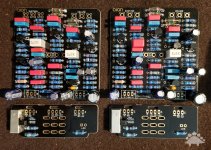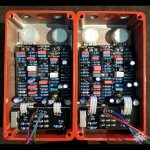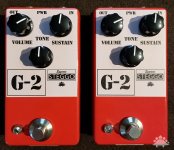Fingolfen
Well-known member
Well... this was a learning experience... First and foremost, a big shout out to benny_profane for pointing me to Chuck's post on germanium diodes. It's a little ironic that I have a pedal build whacked by leakage current since I've spent most of my professional career working on semiconductor high-k gate dielectrics.

For these builds I used the AionFX Cygnus board. The parts count is typical for a Cornish pedal, much of which is actually not the effect itself, but the buffers! I used all 1% tolerance resistors, mostly Yageo. The capacitors are all high-end metal film, mostly WIMA and Kemet. The electrolytic capacitors are all Nichicon or equivalent. When it comes to the components that actually shape the pedal's tone like transistors and diodes, I always try and mimic the original as closely as possible. This has sometimes gotten me into trouble, and as it turns out this ended up being one of those times!

Rather than using the American 2N5088 transistors, I used BC549C transistors like the original. The pinout of the BC549 is reversed from the 2N5088, but as AionFX always labels the emitter, base, and collector for transistors on the silkscreen, I'm always able to get them aligned properly using my Peak Atlas analyzer. The real challenge on any G-2 build comes in the diode selection. The build notes for the Cygnus go into great detail on the electronic properties your germanium diodes need to function properly in the circuit. Exact values vary, but most germanium diodes have a forward voltage of 0.2V to 0.4V. The Cygnus / G-2 in original configuration needs diodes with a forward voltage of at least 0.3V. Otherwise, you will have to substitute the diodes out for silicon Schottky diodes (in which case, why build a G-2 - just build a P-2 or other silicon-based clone) or change the resistance of R18 and R19 in the first clipping stage to there is enough signal gain for proper distortion in the second clipping stage. No problem (I think to my naive self), I can just check the forward voltage of the 1N34A germanium diodes using my digital multi-meter, hand select those above 0.3V, and Bob's your uncle - instant awesome G-2 clone! Well, it didn't quite work out that way. I got the pedal together, boxed and on to my spaghetti tester and I immediately noticed something wasn't quite right with it. I mean it worked, but the volume was incredibly low. I had to crank it all the way up to just get back to unity. Once I was there, the pedal actually sounded pretty good, though I also had to crank the distortion a fair amount to get a good signal. I watched a couple of videos of people playing actual G-2 pedals, and they tended to have both knobs past noon as well, but it was clear that there was something else going on limiting the output of my pedal.

Using Chuck's post as a guide, I was able to construct a simple diode leakage current tester using a 100K Ohm resistor, a 9V battery, and a breadboard. As I couldn't test the diodes I'd already soldered into my pedals, I grabbed some from the same batch and checked their leakage current. Oh dearie... dearie my... Their leakage current was extremely high which was likely killing the volume of my pedals. So, I went for a deep dive into my collection of diodes and began looking for alternates. After testing about 30 diodes I found that my collection of 1N270 germanium diodes had the best leakage current. So I selected eight (four of the small form-factor, and four of a larger vintage form factor), that all had leakage currents less than 0.5μA. I then tested the forward voltage on all of the ones with low leakage current. As it turns out, the were all to the low side with an average of about 0.25V. So now not only did I have to try and de-solder and replace four diodes per board, but two resistors as well.

For these first two enclosures, they're a direct homage to the Pete Cornish originals - by Eggeaux Steggo of course. The tone of a G-2 is more bass heavy than most other Big Muff circuits. Honestly I sort of like it. AionFX provides alternative capacitance values for the tone stack to make it sound a bit more like a conventional muff, but again, if that's what you want, why are you building a G-2 in the first place?
More at the blog...

For these builds I used the AionFX Cygnus board. The parts count is typical for a Cornish pedal, much of which is actually not the effect itself, but the buffers! I used all 1% tolerance resistors, mostly Yageo. The capacitors are all high-end metal film, mostly WIMA and Kemet. The electrolytic capacitors are all Nichicon or equivalent. When it comes to the components that actually shape the pedal's tone like transistors and diodes, I always try and mimic the original as closely as possible. This has sometimes gotten me into trouble, and as it turns out this ended up being one of those times!

Rather than using the American 2N5088 transistors, I used BC549C transistors like the original. The pinout of the BC549 is reversed from the 2N5088, but as AionFX always labels the emitter, base, and collector for transistors on the silkscreen, I'm always able to get them aligned properly using my Peak Atlas analyzer. The real challenge on any G-2 build comes in the diode selection. The build notes for the Cygnus go into great detail on the electronic properties your germanium diodes need to function properly in the circuit. Exact values vary, but most germanium diodes have a forward voltage of 0.2V to 0.4V. The Cygnus / G-2 in original configuration needs diodes with a forward voltage of at least 0.3V. Otherwise, you will have to substitute the diodes out for silicon Schottky diodes (in which case, why build a G-2 - just build a P-2 or other silicon-based clone) or change the resistance of R18 and R19 in the first clipping stage to there is enough signal gain for proper distortion in the second clipping stage. No problem (I think to my naive self), I can just check the forward voltage of the 1N34A germanium diodes using my digital multi-meter, hand select those above 0.3V, and Bob's your uncle - instant awesome G-2 clone! Well, it didn't quite work out that way. I got the pedal together, boxed and on to my spaghetti tester and I immediately noticed something wasn't quite right with it. I mean it worked, but the volume was incredibly low. I had to crank it all the way up to just get back to unity. Once I was there, the pedal actually sounded pretty good, though I also had to crank the distortion a fair amount to get a good signal. I watched a couple of videos of people playing actual G-2 pedals, and they tended to have both knobs past noon as well, but it was clear that there was something else going on limiting the output of my pedal.

Using Chuck's post as a guide, I was able to construct a simple diode leakage current tester using a 100K Ohm resistor, a 9V battery, and a breadboard. As I couldn't test the diodes I'd already soldered into my pedals, I grabbed some from the same batch and checked their leakage current. Oh dearie... dearie my... Their leakage current was extremely high which was likely killing the volume of my pedals. So, I went for a deep dive into my collection of diodes and began looking for alternates. After testing about 30 diodes I found that my collection of 1N270 germanium diodes had the best leakage current. So I selected eight (four of the small form-factor, and four of a larger vintage form factor), that all had leakage currents less than 0.5μA. I then tested the forward voltage on all of the ones with low leakage current. As it turns out, the were all to the low side with an average of about 0.25V. So now not only did I have to try and de-solder and replace four diodes per board, but two resistors as well.

For these first two enclosures, they're a direct homage to the Pete Cornish originals - by Eggeaux Steggo of course. The tone of a G-2 is more bass heavy than most other Big Muff circuits. Honestly I sort of like it. AionFX provides alternative capacitance values for the tone stack to make it sound a bit more like a conventional muff, but again, if that's what you want, why are you building a G-2 in the first place?
More at the blog...

